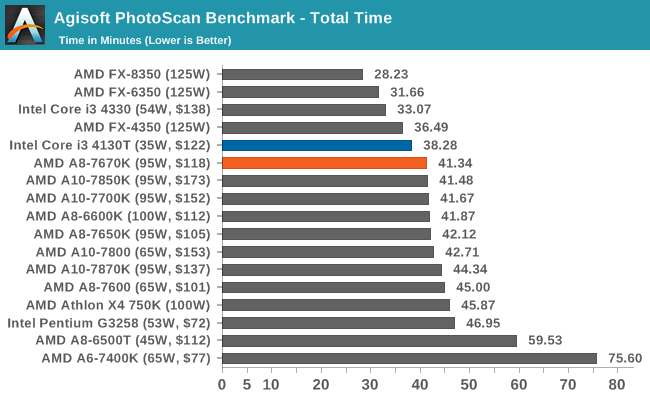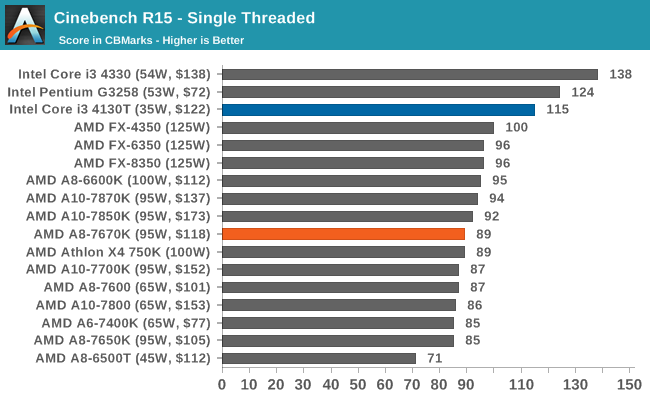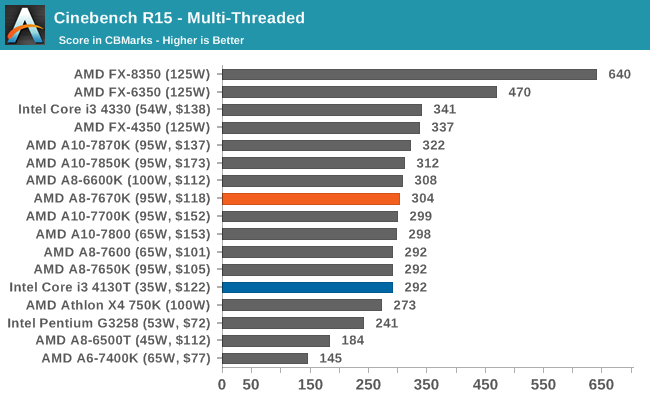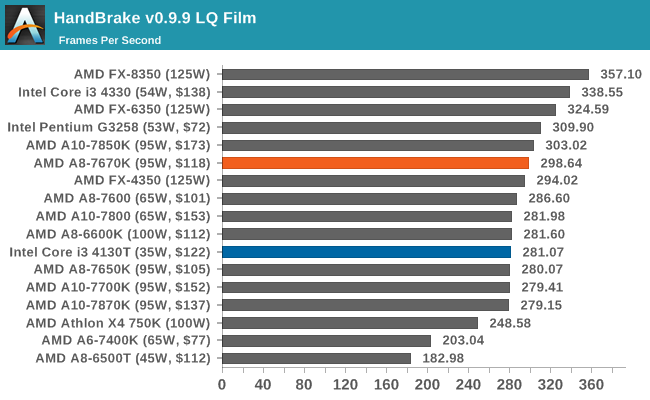The AMD A8-7670K APU Review: Aiming for Rocket League
by Ian Cutress on November 18, 2015 8:00 AM ESTProfessional Performance: Windows
Agisoft PhotoScan – 2D to 3D Image Manipulation: link
Agisoft PhotoScan creates 3D models from 2D images — a process that is very computationally expensive. The algorithm is split into four distinct phases, and different phases of the model reconstruction require either fast memory, fast IPC, more cores, or even OpenCL compute devices to achieve the best performance. Agisoft supplied us with a special version of the software to script the process, where we take 50 images of a stately home and convert it into a medium-quality model. This benchmark typically takes around 15 to 20 minutes on a high-end PC on the CPU alone, with GPUs reducing the time.

PhotoScan shows most APUs performing around 41 to 42 minutes, which suggests that there is a bottleneck in the core design.
Cinebench R15
Cinebench is a benchmark based around Cinema 4D, and is fairly well known among enthusiasts for stressing the CPU for a provided workload. Results are given as a score, where higher is better.


HandBrake v0.9.9: link
For HandBrake, we take a video (a 2h20 640x266 DVD rip) and convert it to x264 format in an MP4 container. Results are given in terms of the frames per second processed, and HandBrake uses as many threads as possible.











154 Comments
View All Comments
Linuxenthusiast - Thursday, November 26, 2015 - link
I think one of the main problems for AMD is that there are very few brand name computers using the faster AMD APUs in the stores. That, combined with all the people that think they “have” to have an Intel processor because it's “better” works against AMD.I have been building desktops for friends and family and friends of friends with AMD cpus exclusively for the past 20 years and AMD APUs for the past four years or so. All the PCs used either the integrated chipset AMD video or the APUs integrated video. I can build a sturdier, longer lasting PC, with higher quality parts at a lower price than brand name PCs by using AMD APUs and motherboards. I basically build them the PCs that they can't buy in the stores.
Most of the users have been web browser/email/YouTube/photos/music users and have been very happy with the price and performance of the PCs and have no idea what they are supposedly “missing” by not having the additional costs of an Intel cpu and motherboard. If you judge the performance of the PC by how well it handles typical multithreaded everyday apps rather than benchmarks, I think you will find that AMD APUs are more than adequate for most users.
In the past year or so, I've built 5 PCs for teenage or twenty-something Windows gamers and one mid-forties gamer who has $500+ invested in a fancy “race-car” seat and pedals and gear shift that feel like ones in a real race car. The race car gamer didn't believe that the AMD APU alone could provide sufficient video performance without an additional add-in video card, but I convinced him to try it with the idea that we could always add a video card later, if he needed it.
Well, much to his surprise, the Kaveri AMD APU was more than adequate for his needs and he's quite happy with it.
The teenagers and twenty-somethings are also using only the IGP of the Kaveri APUs and they are all quite pleased with the performance of the PCs. None of them have asked for an add-in video board. I don't think any of them are playing the most demanding games at the highest possible settings, but the main point is that they are all quite happy with the performance of their PCs and all of them are using the IGP of the Kaveri APUs.
Every time someone thinks they need an Intel cpu, I have been able to convince them to try a PC with an AMD APU and no one has ever been disappointed with the performance of the APU PCs.
I also try to recommend notebooks with AMD APUs and I wish there were more APU-based Thinkpads as well as more APU based Lenovos and HPs and the people who've bought them are also quite happy with their performance.
I would encourage people who've never used AMD APUs to give the current Kaveri and later APUs a try. It won't cost much and I think you'll be pleasantly surprised.
Vesperan - Wednesday, November 18, 2015 - link
I've been pleasantly surprised by what a 7850K (at 2133mhz memory) can achieve. 5-10 years ago I would have said gaming on integrated is impossible, but now you can do a lot on them.That said - I've definately avoided some titles until I get a graphics card.
CaedenV - Wednesday, November 18, 2015 - link
And this is the kicker... even you will still need a dGPU in the end. An APU is either for a non-gaming system that could easily get by with Intel iGPU level graphics; or it is a stop-gap until you can afford a dGPU, after which point the APU is going to be your bottleneck for the rest of it's life. Far better (at least in my opinion) to start with the CPU you want in the long term, limp along with the iGPU until you can find a good GPU on sale.Over the 5-10 year life of a modern computer, what is 3-6 months to scrape together the money for a GPU?
Vesperan - Thursday, November 19, 2015 - link
I'm an outlier (as is anyone reading/posting here) but for me the 7850k is a combination of a few things - supporting AMD as the smaller company, but also recognising my needs. The integrated graphics are perfectly fine for my current gaming needs and I would rather spend the money on a discrete GPU in 2016 when the new process node/GPUs are out than now. I also have two young children so I'm lucky to get 30 min a day on the desktop!Money isnt the issue but like every geek here we need to have a build that is optimal in some way. But yes - when I set out to built an AMD system that made sense I really, really struggled to justify it. Its not only the weakness of the CPU, but the high TDPs relative to performance. Fighting back at Intel while being two process nodes behind is just terrible for AMD.
BlueBlazer - Wednesday, November 18, 2015 - link
Potential buyers would most likely choose either Intel's LGA115x or AMD's AM3+ platform for gaming builds, and overlook/ignore AMD's dead-end FM2/FM2+ platform. That is very much due to future upgradeability considerations, especially the CPU (where AMD's FM2/FM2+ platform is limited to 4 "cores"). Install a powerful discrete GPU and AMD's APU will bottleneck it (which is why a faster CPU is required)...abufrejoval - Wednesday, November 18, 2015 - link
I have come to respect APUs in my main home server. It started with an A10-5800K Trinity APU some years ago, 32GB of RAM and 16TB of RAID6 storage, but when I saw an A10-6700 Richland APU cheap on eBay I swapped it for reduced idle power (22Watts now).It's been running pretty much non-stop for years, and because it's so super quiet I find that most of the time I rather use it for pretty much everything from surfing, to taxing and video rather than wake my heavy dGPU Intel game rig from standby.
It typically runs Windows 2008R2 and then quite a few VMs using VMware workstations and dual monitors.
The original motive was flexibility: 8 SATA ports, 32GB of RAM, full IOMMU/VT-d capabilities, 3 4-16 lane PCIe slots and sufficient graphics power on a very low power and financial budget simply couldn't be had from Intel at the time.
With Skylake Xeons equivalent flexibility and capabilities are starting to appear, while of course it vastly exceeds the APU's performance on some (for me not critical) aspects, but also comes at a significantly different price.
My main disappointments so far have been:
Lack of ECC support with the FM2(+) sockets (I froth at the mouth whenever I think about that stupid cost cutting omission)
Kaveri idle power performance much worse than Richland
Missing Carrizo socket SKU with ECC DDR4 RAM
Missing "game cartidge" variant e.g. with 8GB of GDDR5 soldered on a dGPU form factor PC designed for a passive PCIe backplane, expandable from 1-4 stackable APUs
CaedenV - Wednesday, November 18, 2015 - link
I too am running an A10 5800K CPU for my home server at the moment... but it is because I got it for free (PCIe slot burned out, and my friend didn't want it anymore). But had I been buying an A10 vs a Pentium or i3 for home server use it would hands down be the Intel. Up front costs being equal, even a crappy Celeron is 'good enough' to run a home server as performance is decided by the HDDs and RAM. In the long run the Intel is going to run cooler, quieter, and on less power for a system that is on 24x7. This means lower power bills, less noise produced, less airflow needed, and less dust accumulation.It is not that the AMD is bad as a home server platform (mine has been running great for quite a while now), it is simply not as good. Heck, even with it being free I am considering replacing it next year with an intel system simply because it will pay for itself in power costs alone in just a few years. So even free AMD vs paying for Intel is a toss-up.
DiHydro - Friday, December 4, 2015 - link
It's going to be hard to pay off a new system with a difference of $16 a year, and that is at 50% CPU 24/7, which is extremely high for a home server.Computer Bottleneck - Wednesday, November 18, 2015 - link
Eight 6 Gbps SATA ports on A88X is pretty sweet, but yes it would be great to see ECC on this platform as well. Also more Mini-ITX FM2+ boards.spinportal - Wednesday, November 18, 2015 - link
That's a power hungry bugger that trades blows with the i3 4130T, but not acceptable TDP for a laptop or NUC. Nice try, but misses the mark as a desktop chip or a mini-platform.